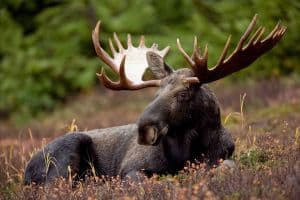
There are about as many moose as last year on the Kabetogama Peninsula, sandwiched between Rainy and Kabetogama Lakes in Voyageurs National Park. The National Park Service’s annual aerial survey gave biologists an estimate of 46 animals, which is consistent with population estimates from the past five years.
While the population has not declined significantly, as has raised sharp concerns elsewhere in northern Minnesota, scientists still saw troubling trends. Few calves were observed, and no pairs were seen.
But still, the park’s population seems to be faring better than in the rest of the state, where the overall population has declined by 60 percent in the past decade. While the overall northeastern Minnesota herd has seen mortality rates up to 20 percent since 2010, it has remained at about seven percent in Voyageurs.
“The continued apparent stability of the low-density population in Voyageurs is corroborated through ongoing monitoring of GPS-collared moose,” the park stated in a news release. “None of the 10 collared adult moose have died since the last aerial survey was completed in 2014. Three additional collared moose survived at least 2-10 months until we lost contact with their collars.”
One of the explanations for why Voyageurs’ moose are doing better is the abundance of other, easier prey for wolves. While increasing wolf numbers in northern Minnesota are thought to be one reason the overall population is declining, wolves prefer feeding on whitetail deer and beavers, both of which are abundant on the Kabetogama Peninsula. An analysis of wolf scat has shown wolf diets were comprised of 5-13% moose in Voyageurs, compared to 32-54% in other parts of the northeastern region.
Most of the park’s moose live in a 118-square mile roadless wilderness area on the Kabetogama Peninsula. The park is on the southern edge of the moose range in North America, and it’s believed that global warming may be stressing the big animals, hurting their reproduction, and degrading the habitat necessary for them to survive warm weather. Meanwhile, disease and parasites are also taking a toll.
To shed more light on forces affecting the park’s moose population, other research projects currently underway include studies of how temperature affects different types of moose habitat; the role of deer, snails, and slugs factor into fatal brainworm parasites; moose behavior responding to high temperatures and other weather events; identifying potential climate change refuges for moose; the relationships between moose, deer, beavers, and wolves; and the role of wetlands for moose foraging and temperature regulation.

